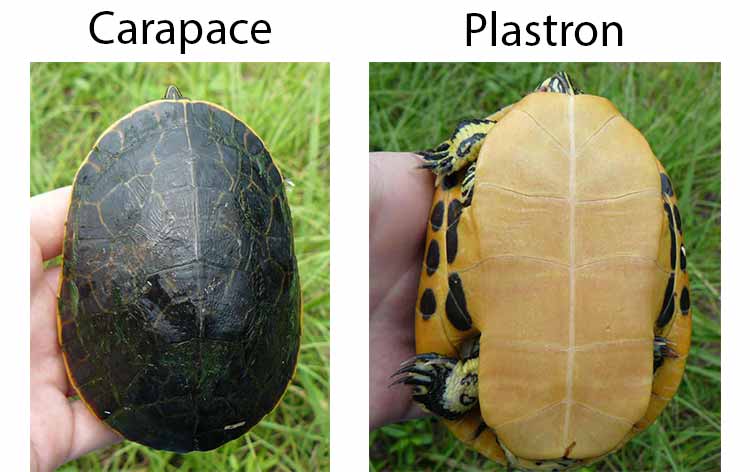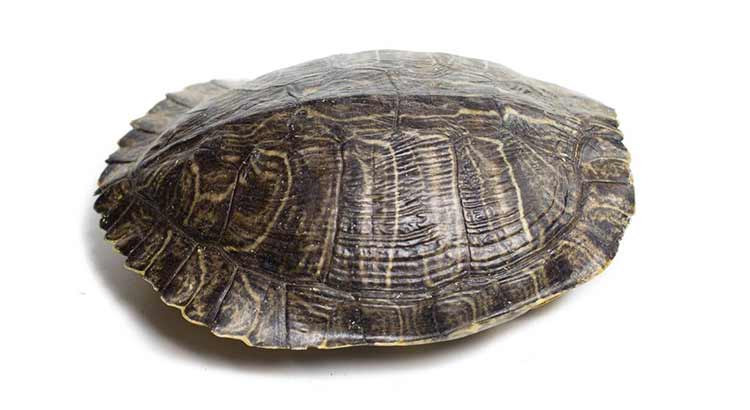The thing that makes turtles so unique is the shell. I was curious to find out what the shell is made out of, so I decided to do some research. Here is what I found out.
What are turtle shells made of? Turtle shells are made out of bones, and the exterior is covered with a keratin layer.
The bones that make the shell are made out of the same things all bones are made out of: collagen, which is a protein, and calcium phosphate, and calcium carbonate. What makes the turtle shells so special is the way they are fused together. So let’s take a closer look at how the shell is made.
The Parts of a Turtles Shell
The turtle shell is made out of two main parts, the carapace, and the plastron. And two secondary parts.

The Carapace
The carapace is the upper part of the shell, the part that covers the back of the turtle, and it’s usually in the shape of a dome.
The carapace is mostly made out of broad and flattened ribs that have fused together, along with parts of the backbone.
The backbone is fused with the rest of the carapace, but a significant part of it can still be distinguished from the rest of the bones, unlike the ribs that have fused completely.
Turtles are the only animals in the world that have all of their ribs fused into one big piece, every other animal has multiple ribs that are separated from each other.
There are over 300 different species of turtles, and all of them have a different shell shape, some of them have a rounder shell, some of them have a more pronounced dome shape, and some of them have almost flat shells, but all of them have the same bone structure on the inside. Even if the shell has a different shape.
The carapace is the most exposed part of the shell, so it also has the role to protect the turtle from any danger.
The bony carapace offers the turtle a good defense against predators. But the bones that make the shell have a limit. Just like our bones they can break if there is too much pressure applied to them. And just like our bones, they can heal, but up to a point.
If the carapace is completely cracked the turtle doesn’t have any chance of survival, just like we can’t completely heal our bones without surgical intervention, neither they can’t.
But if the carapace is cracked just a little then there is a chance that it can heal on its own.
Now let’s talk about the other side of the shell, the plastron.
The Plastron
The plastron is the posterior part of the turtle. This part is usually flat, but at some turtle species, it can be a little curve.
The plastron is made up of nine bones and two epiplastra. Here is a list of the names of each bone:
At the moment the evolution of the plastron is a mystery. In the case of the carapace, we know that it was formed due to the fusion of the ribs and the backbone. But when it comes to the plastron there is no sure answer. The most accepted theory was discovered in the 19th century by a French zoologist, who suggested that the plastron is developed by the sternum of the turtle. But at the moment his theory hasn’t been proven.
The carapace and the platoon are the main parts that compose the shell, but the shell has two other important parts, one that connects the carapace and the plastron, and one that protects the carapace.
The Bridge
The bridge is the part that connects the carapace and the plastron, and it can be found on the sides of a turtle.
The origins of the bridge are also unknown. But most probably the bridge is also formed from fused ribs.
The bridge has two roles, to protect the sides of the turtle, and to keep the carapace and the plastron fused. Even if the bridge doesn’t do too many things, the things that it does are vital.
Now let’s move to the final part.
The Scutes
The carapace of a turtle is covered with scutes. Scutes are made out of keratin. Keratin is the same thing that our nails are made out of.
Scutes act as a layer of protection for the carapace. Most turtles are going to shed their scutes and grow new ones. So if an animal bites them, the scutes will get damaged instead of the carapace. And since they can shed the scutes away and grow new ones, it won’t be such a big problem.
But not all turtles can shed their scutes. Tortoises, which are turtles that don’t live in the water, won’t shed their scutes. Instead, they will grow new ones on top of the ones that they already have.
There are a few soft-shelled turtles that don’t have scutes, but instead, they have something similar to leather that covers their body. Here is one example:
How Turtles Got Their Shell
How turtles got their shell is still not very clear. Over the years there have been a lot of theories. At some point, there were two big theories that covered this subject.
The first one suggested that the earliest turtles didn’t have shells, but instead, they had something similar to the scutes of modern turtles on their back. And that through the ages they gathered even more scutes, that ended up fusing with the bones underneath and ended up forming the shell that we see today.
The other theory suggested that the ribs of the ancient turtles started to extend and broaden, until they ended up fusing together, resulting in the shell that we know.
Today we know that the first theory was wrong and that the shell is the result of the ribs that extended and fused together. But the reason why this happened is still unknown.
Some of the oldest fossils have shown that the first turtles that were getting close to how modern turtles look, only had the plastron, and no carapace. Instead of a carapace, they had ribs like most animals do. The name of that turtle species is odontochelys, and it lived around 220 million years ago.
In 2016 scientists have come out with a theory that tells us why turtles have evolved to have a shell. Some of the oldest turtle fossils suggest that turtles were not living in the water, instead, they were land animals that liked to burrow. The theory suggests that the wider ribs would provide a lot of stability for the ancient turtles as they were digging.
Wider ribs provide more stability for the trunk, and that is perfect for digging. Similar wide ribs can also be observed in other animals that like to dig burrows, the anteater for example.
The problem with wide ribs is that they greatly reduce mobility. As a result, turtles are not able to move too fast. And this means that the turtles were more vulnerable to predators. At this point, the ribs started to fuse together forming the shell as we know it. This offered turtles more protection and also allowed them to dig.
As turtles evolved they started spending a lot more time in the water, and less time digging. But the shell remains there for the moment. It’s always possible that the shape or the composition of the shell to change.
This is just a theory. There are a lot of things that this theory doesn’t completely explain, but at the moment it’s what we can get with the amount of information that we have.
Here is a video that shows how the bones of the turtles evolved.
And here is a video of a turtle shell being cut in half:
Related Questions
How many bones does a turtle carapace have? A turtle shell has around 50 bones. It’s really hard to see the difference between them since they are fused together, but biologists have determined that there are about 50 bones.
Are turtles born with a shell? Yes, turtles are born with a shell. When the baby turtle emerges from the egg, it emerges with a well-developed shell.
Do turtles shells heal? Turtle shells can heal minor injuries, but if the shell is completely cracked, the turtle will not be able to help its shell.


